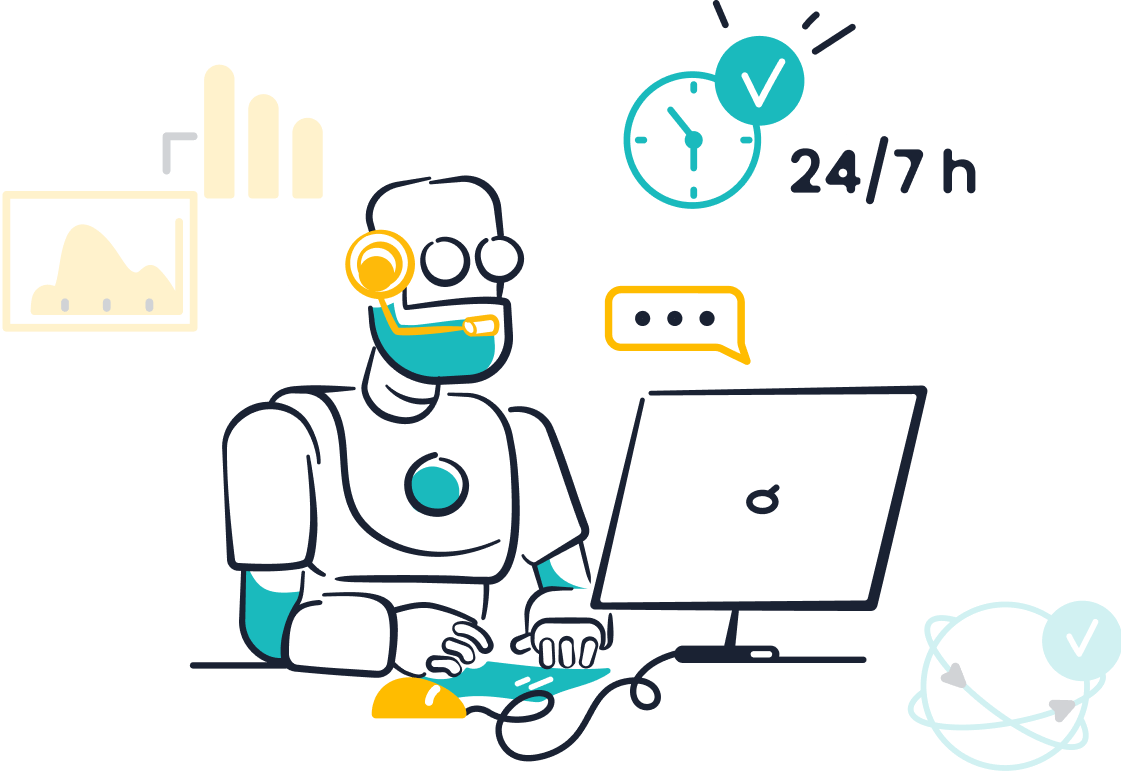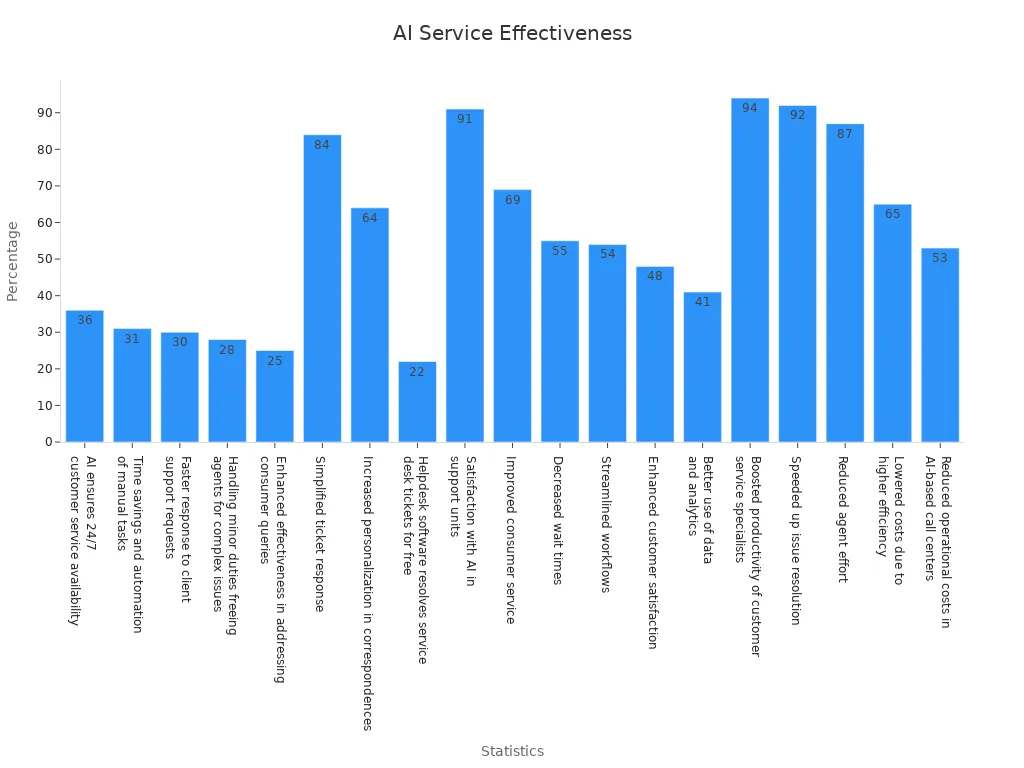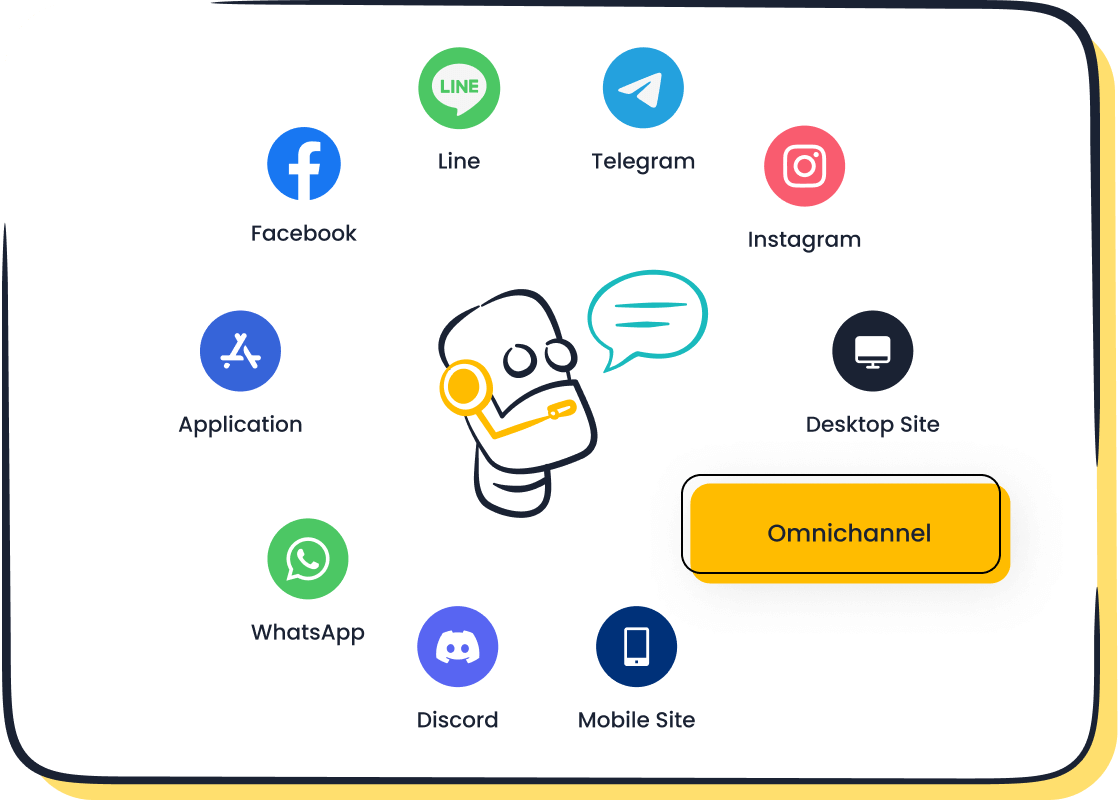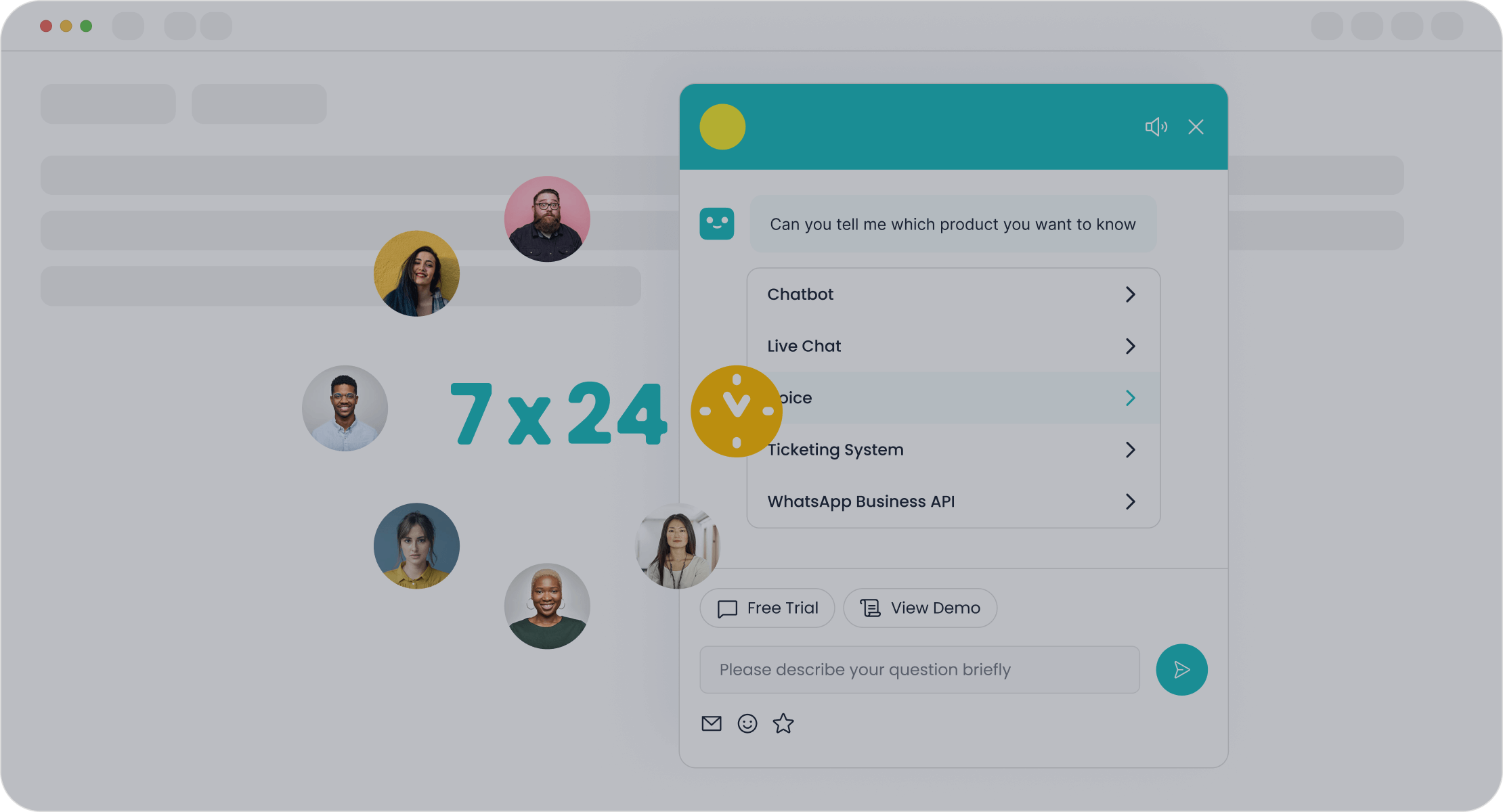AI-Driven Customer Service Tools for Automation Compared

Imagine a world where customer service feels effortless—questions answered instantly, issues resolved in record time, and costs kept in check. AI is transforming this vision into reality for businesses. You’ve probably noticed how companies now use chatbots or virtual assistants to speed up responses. In fact:
- Companies using AI report a 37% drop in first response times.
- AI-powered tools help resolve tickets 52% faster.
- Businesses see a 35% cost reduction in customer service operations.
With AI, you can scale operations, improve customer satisfaction, and save money. But knowing how to automate customer service effectively starts with choosing the right tool for your needs. That’s where solutions like Sobot come in, offering smart automation tailored to modern business challenges.
Benefits of AI-Driven Customer Service Tools

How AI Improves Efficiency and Speed
AI takes customer service automation to a whole new level by making processes faster and more efficient. Imagine this: a customer asks a question, and instead of waiting for an agent, they get an instant response from a chatbot. AI-powered tools like chatbots and virtual assistants ensure 24/7 availability, reducing wait times and keeping customers happy.
These tools also handle repetitive tasks like ticket routing, data entry, or processing refunds. By automating these processes, AI frees up your team to focus on more complex issues. This not only boosts productivity but also ensures that your customers get the attention they deserve when it matters most.
AI doesn’t just stop there. It analyzes past performance data to identify what works and what doesn’t. It even detects mistakes in your system, helping you fix problems before they escalate. This proactive approach keeps your operations running smoothly and your customers satisfied.
Cost Savings Through Automation
Automated customer service isn’t just about speed—it’s also about saving money. Chatbots and virtual assistants handle routine queries, cutting down the need for additional agents. Automated call centers manage basic voice interactions, reducing staffing costs even further.
AI analytics tools also play a big role. They help you understand customer behavior and predict inquiries, allowing you to optimize resources. For example, AI can forecast call volumes and create shift schedules that balance workloads and reduce overtime costs. It even identifies trends to resolve issues before they become expensive problems.
By minimizing human error and improving efficiency, automation tools lead to long-term savings. Businesses not only cut costs but also improve service quality, creating a win-win situation for everyone involved.
Enhancing Customer Satisfaction with AI
When it comes to customer satisfaction, AI is a game-changer. Automated tools provide personalized experiences by analyzing customer data and tailoring interactions to individual needs. This makes customers feel valued and understood.
AI also enhances agent performance. It summarizes interactions and provides actionable insights, helping your team deliver better service. Plus, by handling basic tasks autonomously, AI reduces ticket volumes and ensures faster resolutions.
Here’s a quick snapshot of how AI benefits your business:
| Benefit/Improvement | Description |
|---|---|
| Customer Satisfaction | AI tools enhance customer satisfaction by providing personalized experiences and efficient service. |
| Agent Performance | AI improves agent performance by summarizing interactions and providing actionable insights. |
| Operational Efficiency | AI reduces ticket volumes by handling basic tasks autonomously, streamlining operations. |
With AI, you’re not just meeting customer expectations—you’re exceeding them.
Scalability for Businesses of All Sizes
AI-driven customer service tools aren’t just for big corporations. They’re designed to grow with your business, whether you’re running a small startup or managing a global enterprise. That’s the beauty of scalability—it adapts to your needs, no matter how much your business evolves.
For smaller businesses, AI tools can handle repetitive tasks like answering FAQs or routing tickets. This reduces operational costs and frees up your team to focus on growing your business. As your company expands, these tools scale effortlessly, managing higher volumes of customer interactions without breaking a sweat. You don’t need to worry about hiring more agents or overloading your current team.
Larger businesses benefit from AI’s ability to provide consistent service across multiple regions. Imagine having the same high-quality customer experience in New York, Tokyo, and Paris. Scalable AI ensures uniform performance and data processing, no matter where your customers are. It also helps you make quick decisions by analyzing real-time data, keeping your operations efficient and responsive.
Here’s a quick look at how scalability benefits businesses of all sizes:
| Benefit | Description |
|---|---|
| Cost Reduction | AI automates repetitive tasks, reducing operational costs and enhancing efficiency. |
| Enhanced Decision-Making | AI provides real-time data analysis, helping companies identify inefficiencies and make informed decisions. |
| Customer Experience | AI technologies improve customer interactions, leading to increased satisfaction and revenue growth. |
| Global Consistency | Scalable AI allows uniform deployment across regions, ensuring consistent performance and data processing. |
Scalability also supports innovation. AI identifies trends and opportunities for new products or services, helping your business stay ahead of the curve. Whether you’re launching a new product or entering a new market, AI tools grow with you, ensuring you’re always ready for the next big step.
With AI, you’re not just investing in a tool—you’re investing in a partner that grows with your business. So, whether you’re just starting out or already a market leader, scalable AI solutions ensure you’re equipped to handle whatever comes next.
Top AI-Driven Customer Service Tools Compared
When it comes to automated customer service, choosing the right tool can make all the difference. Let’s dive into three standout customer service tools—Zendesk, Intercom, and Genesys Cloud CX—and see how they stack up.
Zendesk - Customization and Scalability
Zendesk is a powerhouse in customer service automation, offering a blend of customization and scalability that suits businesses of all sizes. Whether you’re a startup or a global enterprise, Zendesk adapts to your needs effortlessly.
What makes Zendesk shine? Its customizable agent workspace and unified omnichannel experience. You can manage customer interactions across email, live chat platforms, and social media—all from one place. This multichannel support ensures your customers get consistent service, no matter how they reach out.
Zendesk also excels in automation tools. It simplifies workflows, automates ticket routing, and provides real-time assistance to agents. These features reduce response times and improve efficiency. Plus, its scalability means you can handle increasing customer demands without breaking a sweat.
Here’s a quick comparison of Zendesk’s features:
| Feature | Zendesk | Front |
|---|---|---|
| High customer satisfaction at scale | ✔ | ✘ |
| Unified omnichannel experience | ✔ | ✘ |
| Customizable agent workspace | ✔ | ✘ |
| Sophisticated automation + workflows | ✔ | ✘ |
| Highly rated integrations | ✔ | ✘ |
Zendesk’s ability to deliver 24/7 support and streamline workflows makes it a top choice for businesses looking to enhance their customer service platforms.
Intercom - Premium Features for Engagement
If you’re looking for a tool that focuses on customer engagement, Intercom is a fantastic option. It’s not just about answering questions—it’s about building relationships. Intercom combines live chat tools, email marketing, and AI chatbot included features to create a seamless customer experience.
One of Intercom’s standout features is its real-time assistance. Imagine a customer browsing your website and receiving instant help through a chatbot or live chat platform. This proactive approach keeps customers engaged and reduces bounce rates.
Intercom also offers premium features like targeted messaging and in-app support. These tools allow you to personalize interactions based on customer behavior, making every conversation feel unique. Plus, its AI-powered tools analyze customer data to provide actionable insights, helping you improve your service continuously.
Here’s why Intercom stands out:
- Engagement-focused tools: Live chat platforms and AI chatbot included features keep customers connected.
- Personalization: Tailored messages and real-time assistance enhance customer satisfaction.
- Scalability: Handles growing customer demands with ease.
Intercom’s focus on engagement and personalization makes it a go-to choice for businesses aiming to build lasting customer relationships.
Genesys Cloud CX - Comprehensive Contact Center Solution
Genesys Cloud CX takes customer service automation to the next level with its all-in-one contact center solution. It’s perfect for businesses that need a robust platform to manage complex customer interactions.
What sets Genesys Cloud CX apart? Its workforce engagement suite. This feature enhances employee performance through training, assessments, and performance metrics. Employees can track their progress using a unified scorecard, while managers identify gaps and provide coaching to improve KPIs.
Here’s what you’ll love about Genesys Cloud CX:
- Comprehensive tools: From AI chatbot included features to multichannel support, it covers all bases.
- Employee engagement: Training and performance tracking tools boost productivity.
- Real-time assistance: Managers can make quick decisions based on real-time data.
A study by Gartner found that 86% of organizations view employee engagement as crucial for achieving customer experience goals. Genesys Cloud CX aligns perfectly with this vision, offering a platform that benefits both customers and employees.
Pro Tip: If you’re managing a large team, Genesys Cloud CX’s workforce engagement tools can help you streamline operations and improve service quality.
Genesys Cloud CX is more than just a customer service software—it’s a comprehensive solution that enhances every aspect of your contact center.

With tools like Zendesk, Intercom, and Genesys Cloud CX, you’re not just automating customer service—you’re transforming it.
Freshdesk - User-Friendly and Affordable
Freshdesk stands out as one of the most approachable customer service tools for businesses of all sizes. Its intuitive interface makes it easy for your team to get started without extensive training. Whether you're managing a small startup or a growing enterprise, Freshdesk simplifies customer service automation with tools that streamline operations.
What makes Freshdesk appealing is its affordability. You don’t have to break the bank to access features like ticketing systems, workflow automation, and multichannel support. These tools help you manage customer inquiries efficiently, saving time and resources.
Here’s why Freshdesk is a favorite among businesses:
- It integrates communication channels like email, chat, and social media into one platform.
- Automation tools reduce repetitive tasks, freeing up your team for more critical issues.
- Its ticketing system ensures that no customer query slips through the cracks.
However, some users have noted gaps between subscription plans. While the basic plan is budget-friendly, advanced features may feel pricey for smaller businesses. Despite this, Freshdesk remains a solid choice for those seeking user-friendly and affordable customer support tools.
Sobot Chatbot - AI-Powered Multilingual Automation

If you’re looking for automated customer service that goes beyond the basics, Sobot Chatbot is a game-changer. This AI-powered tool doesn’t just answer questions—it transforms how you interact with customers.
Imagine a chatbot that operates 24/7, speaks multiple languages, and handles queries across platforms like WhatsApp and SMS. That’s Sobot Chatbot in action. It’s designed to improve efficiency, cut costs, and boost conversions. For example, businesses using Sobot Chatbot report a 70% increase in productivity and save up to 50% on agent costs.
Here’s what makes Sobot Chatbot unique:
- Omnichannel support: Customers can reach you through their preferred apps, ensuring seamless communication.
- Multilingual capabilities: It interacts with customers in their native language, breaking down barriers.
- No coding required: You can set it up with a simple point-and-click interface.
Sobot Chatbot doesn’t just stop at answering FAQs. It uses proactive messaging and real-time intent analysis to guide customers through their journey. This approach boosts conversion rates by 20% and helps businesses gain 30% more leads.
Take OPPO, for instance. By implementing Sobot Chatbot, the company achieved an 83% resolution rate and a 94% positive feedback score. These results highlight how Sobot’s AI-powered tools can elevate your customer service game.
Want to learn more? Explore Sobot Chatbot’s features here.
How to Automate Customer Service with the Right Tool
Understanding Business Needs and Goals
Before diving into automation, you need to understand your business needs and goals. Start by asking yourself: What do you want to achieve with customer service automation? Is it faster response times, reduced costs, or improved customer satisfaction? Setting clear goals helps you align your efforts with broader business objectives.
Think about your customers. Studies show that 91% of customers are likely to make repeat purchases after an excellent service experience. On top of that, 63% expect personalized attention. These insights highlight the importance of tailoring your automation strategy to meet customer expectations.
To guide your decision-making, follow these steps:
- Identify the essential features your business needs, like omnichannel support or AI-powered chatbots.
- Evaluate how automation tools fit into your existing systems, especially if you use multiple ERPs.
- Consider the level of IT support available for implementation and maintenance.
When your goals align with your customer service tools, you’ll create a seamless experience that keeps customers coming back.
Evaluating Features and Integration Capabilities
Choosing the right customer service software means evaluating its features and integration capabilities. Look for tools that simplify processes and enhance efficiency. For example, platforms with AI automation can handle repetitive tasks like ticket routing and analyze customer data for actionable insights.
Integration is key. Your customer support tools should work seamlessly with existing systems like help desk software or CRM platforms. Here’s a quick comparison of evaluation criteria:
| Evaluation Criteria | Description |
|---|---|
| Integrations | Tools should integrate seamlessly with existing help desk software to streamline processes. |
| AI automation | Use of AI to automate repetitive tasks and analyze ticket content for better efficiency. |
| Reports and analytics | Actionable reports that cover key performance indicators (KPIs) are essential for decision-making. |
| Channel-specific features | Tools should support various communication channels for comprehensive QA reviews. |
| Ease of use | User-friendly interfaces reduce onboarding time and resource requirements. |
By focusing on these criteria, you’ll find customer service software that fits your needs and enhances your operations.
Budget Considerations and ROI Analysis
Investing in automation tools requires careful budget planning and ROI analysis. Start by assessing the financial impact of your chosen customer service software. Tools with features like AI-driven analytics and cost avoidance mechanisms can save money in the long run.
To evaluate ROI, consider metrics like payback period and total value of ownership (TVO). Businesses typically aim to recover their investment within 12-24 months. Here’s a breakdown of financial models:
| Financial Model/Metric | Description |
|---|---|
| Cost-Benefit Analysis | Evaluates the financial implications of AI investments by comparing costs against expected benefits. |
| Total Value of Ownership (TVO) | Extends traditional ownership metrics to include value creation alongside costs. |
| Payback Period | The time required to recover initial investment costs, typically targeted at 12-24 months for AI initiatives. |
| Economic Efficiency | Measures the output generated relative to AI investment inputs. |
Automation tools don’t just save money—they create value. By reducing downtime, improving efficiency, and enhancing customer satisfaction, they deliver long-term benefits that outweigh initial costs.
Importance of User Experience and Support
When it comes to customer service tools, user experience (UX) and support can make or break your success. Imagine using a tool that’s clunky, confusing, or hard to navigate. Frustrating, right? That’s why choosing software with a smooth and intuitive interface is so important. It’s not just about what the tool can do—it’s about how easy it is for you and your team to use it.
Here’s why UX matters:
- Saves Time: A well-designed tool helps you complete tasks faster. No more wasting time hunting for features or figuring out how things work.
- Boosts Productivity: When your team finds the software easy to use, they can focus on what really matters—helping your customers.
- Reduces Errors: Clear layouts and simple workflows minimize mistakes, keeping your operations smooth.
But great UX isn’t enough. You also need reliable support. Even the best tools can run into issues, and when that happens, you’ll want a team that’s ready to help.
Pro Tip: Look for tools that offer 24/7 support, detailed FAQs, and training resources. These features can save you a lot of headaches down the road.
Here’s a quick comparison of what to look for in UX and support:
| Feature | Why It’s Important |
|---|---|
| Intuitive Interface | Makes the tool easy to learn and use, even for beginners. |
| Training Resources | Helps your team get up to speed quickly. |
| Responsive Support Team | Ensures you get help when you need it most. |
| Self-Service Options | Empowers you to solve minor issues without waiting for assistance. |
Remember, a tool that’s hard to use or lacks support can slow you down. Prioritize UX and support to ensure your customer service automation runs smoothly and keeps your team happy.
Use Cases for Customer Service Automation Tools
E-commerce and Retail: Enhancing Customer Journeys
In e-commerce and retail, automation tools are transforming how you connect with customers. These tools help you create seamless shopping experiences, from the moment a customer lands on your website to the final checkout. For instance, chatbots can answer questions about product availability or shipping times instantly, keeping customers engaged and reducing bounce rates.
Some companies have seen remarkable results. A global athletic apparel retailer improved customer engagement by redesigning their communication emails and checkout process. This reduced cart abandonment rates significantly. Similarly, Sephora’s omnichannel strategy, which integrates digital and in-store experiences, led to an 11% increase in average order value and a 20% boost in conversion rates. These examples show how automation can enhance every step of the customer journey.
Call Centers: Streamlining Operations
Call centers often deal with high volumes of inquiries, making efficiency a top priority. Automation tools can help you streamline operations by handling repetitive tasks like routing calls or answering FAQs. This allows your agents to focus on resolving complex issues, improving both productivity and customer satisfaction.
Consider this: improving the First Call Resolution (FCR) rate from 70% to 95% can save a call center with 1,000,000 monthly calls up to $15 million annually. By reducing follow-up calls, automation tools not only cut costs but also enhance the customer experience. Studies from SQM Group highlight how operational practices, like using AI for call routing, can significantly impact FCR rates. With the right tools, your call center can become a hub of efficiency.
SaaS Companies: Supporting Complex Queries
For SaaS companies, customer inquiries often involve technical or complex issues. Automation tools like AI-powered chatbots can assist by providing quick answers to common questions or escalating more complicated problems to the right team. This ensures your customers get the help they need without unnecessary delays.
Leading tools like Salesforce Einstein Bots and HappyFox AI Resolve are already making waves. They predict optimal resolutions and automate tasks, boosting agent productivity by 28% and reducing support costs by 29%. Additionally, robotic process automation (RPA) has helped companies cut manual effort by 90%. These tools not only improve efficiency but also enhance the overall customer experience, making them invaluable for SaaS businesses.
Financial Services: Ensuring Compliance and Efficiency
In financial services, compliance and efficiency are non-negotiable. You’re dealing with sensitive data, strict regulations, and high customer expectations. That’s where AI-driven customer service tools come in. They help you stay compliant while streamlining operations.
AI tools analyze financial activities to detect irregular patterns. They identify high-risk transactions and potential fraud attempts. This proactive approach ensures your business stays ahead of compliance threats. For example:
- AI scans transactions in real time to flag suspicious activities.
- Machine learning enhances detection accuracy over time.
- Automated compliance monitoring instantly identifies risks and policy violations.
These tools also simplify compliance reporting. They align financial statements with current laws, reducing the risk of penalties. Imagine having error-free audit records without the manual hassle.
Did you know? Automated compliance documentation keeps your records up-to-date, saving time and reducing errors.
Here’s a quick look at how automation improves compliance and efficiency:
| Metric | Improvement Percentage |
|---|---|
| Service Efficiency | 59% |
| Reduction in Risk | 28% |
By adopting AI-driven tools, you’re not just meeting regulatory requirements—you’re exceeding them. Tools like Sobot’s omnichannel solution integrate seamlessly into financial workflows, ensuring compliance while enhancing customer satisfaction.
Sobot Omnichannel Solution: A Unified Approach
Managing customer interactions across multiple channels can feel overwhelming. That’s why you need a unified solution. Sobot’s omnichannel platform brings everything together, making your customer service seamless and efficient.
With Sobot, you can handle inquiries from email, social media, live chat, and even WhatsApp—all in one place. This unified workspace eliminates the chaos of switching between platforms. It also gives your agents access to customer data in real time, so they can provide personalized support.
Here’s what makes Sobot’s omnichannel solution stand out:
- AI-driven automation: Handles repetitive tasks, freeing up your team for complex issues.
- Proactive insights: Helps you optimize team configurations and improve service quality.
- Multichannel support: Ensures customers can reach you through their preferred platforms.
Take OPPO, for instance. By integrating Sobot’s solutions, they achieved an 83% chatbot resolution rate and a 94% positive feedback score. This shows how Sobot’s tools can transform your customer service operations.
Ready to unify your customer service? Sobot’s omnichannel solution is here to help. Explore more here.
Future Trends in AI-Driven Customer Service

Advancements in Natural Language Processing (NLP)
Natural Language Processing (NLP) is reshaping how businesses interact with customers. You’ve probably noticed how chatbots and virtual assistants are getting smarter. They don’t just answer questions—they understand context, tone, and even emotions. This is where NLP shines. It allows AI to analyze customer conversations in real time, making interactions feel more human.
Imagine a chatbot that not only answers your question but also detects frustration in your tone and offers a solution before you even ask. That’s the future of customer service. AI-backed sentiment analysis tools are already gaining popularity for this reason. They use NLP to analyze emotions, helping businesses respond more effectively.
The impact goes beyond better conversations. Gartner predicts that conversational AI will cut contact center costs by $80 billion by 2026. With 10% of agent interactions automated, businesses can focus on delivering exceptional service while saving money.
Personalization Through AI and Machine Learning
Personalization is no longer a luxury—it’s a necessity. Customers expect tailored experiences, and AI-powered tools make this possible. By analyzing real-time data, AI creates hyper-personalized interactions that make every customer feel valued.
Think about this: personalization can reduce customer acquisition costs by up to 50%. It’s not just about saving money—it’s about building loyalty. Companies that prioritize personalization see three times the revenue growth compared to their peers. CEOs are catching on, with 86% considering personalization essential for their customer experience strategies.
AI doesn’t just stop at personalization. Machine learning takes it a step further by predicting customer needs. For example, if a customer frequently buys skincare products, AI can recommend complementary items like sunscreen or moisturizer. This proactive approach boosts sales and enhances the shopping experience.
Omnichannel Integration for Seamless Experiences
Customers don’t stick to one platform—they switch between email, social media, and live chat. That’s why omnichannel integration is crucial. It ensures your customers get a seamless experience, no matter how they reach out.
AI-powered tools play a big role here. They unify customer interactions across channels, giving your team a complete view of each customer’s journey. This makes it easier to provide personalized support and resolve issues quickly.
Businesses are already seeing the benefits. A study shows that 65% of companies plan to expand their AI usage in customer experience by 2025. This growing confidence in AI highlights its potential to transform omnichannel strategies.
Omnichannel integration isn’t just about convenience—it’s about consistency. Whether your customer contacts you via WhatsApp or email, they should receive the same high-quality service. With AI, you can make that happen effortlessly.
Ethical AI and Data Privacy Considerations
When you think about AI in customer service, it’s easy to focus on speed and efficiency. But have you ever wondered how ethical AI and data privacy fit into the picture? These two factors are just as important as the technology itself. After all, your customers trust you with their personal information. Protecting that trust should be a top priority.
Why Ethical AI Matters
AI doesn’t just run on algorithms—it runs on data. If the data you use is biased, the results will be too. This can lead to unfair treatment of customers or even discrimination. For example, imagine a chatbot that prioritizes certain customer queries based on flawed data. That’s not just bad for business—it’s unethical.
To ensure fairness, you need to focus on transparency. Customers should know when they’re interacting with AI and how their data is being used. Ethical AI also means designing systems that respect human values, like equality and privacy.
Tip: Always audit your AI tools to check for biases. Regular updates can help keep your systems fair and accurate.
Data Privacy: A Non-Negotiable
Your customers share sensitive information with you—names, emails, even payment details. It’s your job to keep that data safe. AI tools should comply with data protection laws like GDPR or CCPA. These regulations ensure that customer data is handled responsibly.
Here’s how you can prioritize data privacy:
- Encrypt customer data to prevent unauthorized access.
- Limit data collection to only what’s necessary.
- Provide clear privacy policies so customers know how their data is used.
| Best Practice | Why It’s Important |
|---|---|
| Data Encryption | Protects sensitive information from cyber threats. |
| Transparency in Policies | Builds trust by showing customers you value privacy. |
By focusing on ethical AI and strong data privacy practices, you’re not just protecting your customers—you’re building a brand they can trust.
AI-driven customer service tools are transforming how businesses interact with customers. They reduce handling times, improve first-call resolution rates, and boost customer satisfaction scores.
| KPI | Description |
|---|---|
| Average Handling Time | Measures the average duration taken to resolve calls. |
| First Call Resolution | Indicates the percentage of calls resolved on the first interaction. |
| Customer Satisfaction Score | Reflects customer feedback on their service experience. |
To make the most of these tools, you need to align them with your business goals. Think about what your customers need and how automation can meet those expectations.
AI isn’t just a tool—it’s shaping the future of customer service. It fosters continuous improvement, minimizes bias, and creates predictive models for success. By adopting AI, you’re not just keeping up—you’re staying ahead.
FAQ
What are the key benefits of using AI in customer service?
AI improves efficiency, reduces costs, and enhances customer satisfaction. It handles repetitive tasks, provides instant responses, and personalizes interactions. This allows your team to focus on complex issues while delivering faster and better service to your customers.
Can AI tools integrate with my existing systems?
Yes, most AI tools, like Sobot, integrate seamlessly with platforms like CRMs, ERPs, and help desk software. This ensures smooth workflows and consistent customer experiences across all channels. Always check compatibility before choosing a tool.
Do I need technical skills to set up AI tools?
Not at all! Many AI tools, including Sobot Chatbot, offer no-code setups. You can use drag-and-drop interfaces or point-and-click workflows to design and deploy automation without any coding knowledge.
How do AI tools handle multilingual customer support?
AI tools like Sobot Chatbot come with multilingual capabilities. They can interact with customers in their preferred language, breaking down communication barriers and improving global customer satisfaction.
Are AI-driven tools suitable for small businesses?
Absolutely! AI tools scale with your business. For small businesses, they handle repetitive tasks like FAQs and ticket routing, reducing costs. As you grow, these tools adapt to manage higher volumes without needing extra resources.
Pro Tip: Start small with basic features and expand as your needs grow.
See Also
Enhancing Efficiency With AI-Powered Customer Support Solutions
Best 10 AI Solutions for Enterprise Call Centers
Transforming Support With AI Customer Service Agents
